| Please access the following URL if you want to secure using SSL. All pages in the site will be secure pages. |
| https://secure02.blue.shared-server.net/www.fish-food.co.jp/message english 10.2020.html |
Welcome to FISH FOOD TIMES
Oct. 2020 issue No.202
![]()

Rainbow runner sashimi
One of the fish that is delicious but has not received much attention
Rainbow runner is a fish that becomes delicious from autumn to winter. Since it is the same carangidae Family as japanese amberjack, it is a relative, but since it is Elagatis Genus instead of Seriola Genus, it is not as close to japanese amberjack as yellowtail amberjack and greater amberjack of the same Seriola Genus. Vertical yellow stripes stand out on the side of the body, and the slender fish with a small head looks very smart.

It has the same taste as other fish species of Elagatis Genus, and it tastes very good especially in the season when fat is on from autumn to winter, but it is not evaluated very much in the fish market and it is traded at a cheap price. It can be said that it is one of the fish that is usually treated unfairly without being noticed by the people in the market.
Considering why rainbow runners are generally rated low, the first factor may be "speed of discoloration".
When the rainbow runner is set to two pieces disassembling, the following very red-colored body appears.
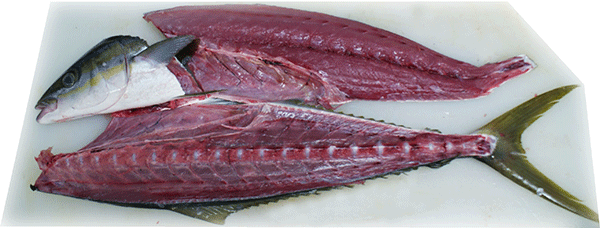
If fish of the family Carangidae, including natural yellowtail, have such a color, it usually turns red and black over time, and if the speed of discoloration is fast, the commercial value will decline quickly. This seems to be one of the reasons why the rainbow runner's evaluation is low.
Next, as shown in the image below, the rainbow runner has less fat and a very smart muscular appearance, so the yield rate is poor. Therefore, if you can get fat, obese natural yellowtail that stores fat at a similar price, the people involved in purchasing will probably prefer natural yellowtail that is rich in fat and has a high yield rate.


The third reason is that rainbow runners live in the warmer waters far south compared to japanese amberjack, so they are rarely caught and unfamiliar. Therefore, there are limited opportunities for customers to purchase rainbow runners because they are not well known, and it is thought that people who sell fish may not be willing to purchase rainbow runners.
For this reason, it seems that the purchasers will not be interested in trading in the rainbow runner market unless the price is basically cheaper than that of natural japanese amberjack.
Product development of cheap rainbow runner
In other words, it is a big advantage that you can get rainbow runner at a low price. I haven't heard that this fish is soaring and not available, so the point of sales will be to take advantage of its low price and commercialize it in a large volume.
When the rainbow runner is set to three pieces disassembling, a red-colored body appears in a relatively thin shape as shown in the image below.
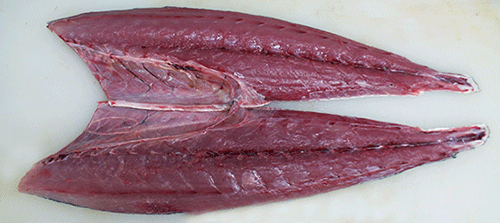
The following is a commercialization of the half body in this image for fillets.
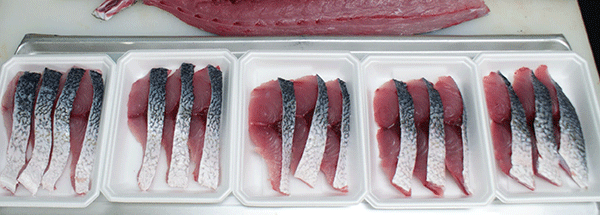
I remember that it was a little less than 5 kg, but the average 70 g fillet was 17 slices. Originally, it seems that it should be commercialized according to the "2/3 principle", but for this rainbow runner, I decided to develop 3 or 4 pieces because the selling price can be reduced.
If you look closely at the part near the head of the fillet, you can see that the part of the belly body is whitish than the back body, and that the rainbow runner has fat on it. By the way, it is stated in the image information that this image was purchased and handled on October 25th of a certain year.
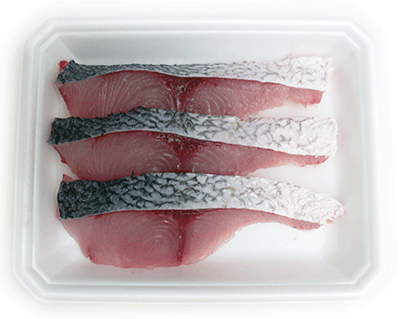
Even if the rainbow runner fillet 70g 3 pieces had a selling price of 380 yen, the markup ratio was about 40%. Considering the balance between the size of the fillet and the selling price, I think it has become a sufficiently attractive product.
Add value with sashimi
Next is the other half of the body. I decided to commercialize sashimi and remove the skin.

When the skin is removed, the surface has a darker red color, and a subcutaneous surface with much less subcutaneous fat appears than natural japanese amberjack.
I decided to create a sense of volume for sashimi by taking advantage of its low price, and decided to commercialize it with a bargain selling price for its volume.
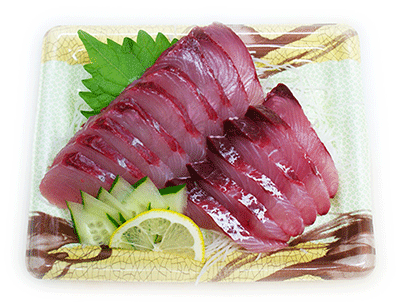
This rainbow runner was at the level of freshness that entered the stage of rigor mortis, but if hiratsukuri sashimi is 480 yen with 15 pieces, the sashimi is easy to buy for its volume, so I think it will work that is an attractive product.
Furthermore, using only the toro part of the rare part where the fat of abdomen is the most, I tried to make a product with higher value by doubling the thickness by the method of usutsukuri sashimi.

Rainbow runner Toro is a unique Toro meat with fat mixed in the shade of red meat and fibrous whiteness, unlike the one in which the milky whiteness due to the large amount of fat is conspicuous like natural japanese amberjack.
Commonly known as Okiburi's real name is rainbow runner
Rainbow runner is called by various names in each region of the country. I'm not going to introduce all of the many aliases, but in some areas the name "Okiburi" is also valid.
Previously, the raw material for a maker-processed product called "Okiburi Teriyaki" sold at the salt-dried section of a mass retailer used to use fish caught in the Southern Hemisphere called Silverwarefu, also known as Ginhirasu. This is probably because it looks just like japanese amberjack when it is made into a fillet, so it probably came from the idea of trying to sell more by arbitrarily giving the name Okiburi as a product name.
However, it is not desirable to use the name Okiburi for this fish, and in July 2007, the Fisheries Agency announced the "Guidelines for Name of Seafood". The product name Oki Buri was listed as one of the "names not to be used", and the product name had to be "Ginhirasu Teriyaki" or "Silver Teriyaki".
This Silverware fu is sometimes called Okimedai because its appearance resembles Bream Ruffe (Medai). In many cases, the word "offshore" is used to confuse the difference between a lesser-known fish and a real fish. For example, Okimebal (Goldeye rockfish), Okiiwashi (Deep-sea smelt), Okisawara (Wahoo), Okianko (Japanese stargazer), Okikamasu (Barracuda), etc.
In this way, in Japan so far, there is a history that somebody has arbitrarily given a favorite name to fish in various places, and it is undeniable that this has created fraudulent acts. In order to eliminate such problems, the national government created and announced guidelines in July 2007. Furthermore, in July of this year, the Consumer Affairs Agency announced the outline of the revision.
After all, 75 kinds of fish species are picked up only in the revised version in 2020. I gave up long ago that I could never know about fish even if it took me a lifetime. However, the "knowledge of edible species of fish" that I have in my head cannot keep up with the scale of undeveloped fishery resources found and developed around the world.
Utilization of minor fish
Rainbow runner seems to be one of the lesser-known minor fishes in the world, but it's hard to see how much this fish is actually caught. This is because, for example, on a set net boat, various fish are landed when the fishing net is pulled up, but some of them are destined to be landed and immediately thrown back into the sea by the fishermen.
One of the iconic fish is the black scraper, and the big and long thorns on the head hurt other fish, and even if you bring it to the fish market, it is only a very cheap price, so the work of landing is black scrapers are thrown away one after another from the top of the ship, judging that it is wasteful.
Not only black scraper is the target of such judgment, but also in the Kinki region such as brassy chub, it is commonly called "poo poo (unkotare)". This is because of the shock when fishing, or because it disturbs the enemy like squid ink, and at the moment of fishing, it gets confused and releases a large amount of excrement. That's why brassy chub is thoroughly ridiculed, and because of its unique odor, it is not traded at all in the fish market.
This brassy chub was taken up in the August 2013 issue of FISH FOOD TIMES No.116, so please refer to it. It was written as follows.
There is a fact that brassy chub is the cause of "rocky-shore denudation (Isoyake)". If this problem is left unchecked, fishery resources in the waters near Japan will be greatly affected, and there is a problem that may lead to a decrease in the catch of Japanese marine products. The term "isoyake" was originally a dialect of the eastern coast of the Izu Peninsula, and describes the decline of the fishing grounds of gelidiaceae, which is the raw material for agar. Generally, the term "isoyake" is used to describe a phenomenon in which the catch of spiny lobsters and abalone that depend on the seagrass beds is significantly reduced due to the death or decline of the seaweed beds. Seagrass beds are forest-like and grassland-like communities formed by seaweed and seagrass. They are places for spawning and habitat of seafood, and are an important foundation for supporting coastal fisheries. One of the causes of the rocky-shore denudation phenomenon and the decrease of seagrass beds is the increase of phytophagous fish species such as brassy chub, Mottled spinefoot and parrotfish. Brassy chub can come to seaweed beds in large groups and eat up seaweed, but this fish is not valued at all in the market and is not traded as a commodity. Therefore, these fish are not targeted by fishermen, and they are becoming more and more powerful with their own faces. The general theory is that brassy chub has a strong odor and is "not delicious to eat", and it leads to "worthless" because it is not delicious, and it is not traded in the market because it is not worth it. "Fishermen do not catch" because they are not handled at the market, and brassy chub is not caught, so it gains power in the sea and devours seagrass beds. As a result, seagrass beds are decreasing, rocky-shore denudation occurs, and fishery resources are declining. In this way, the dangerous composition of the current fishery in the waters near Japan can be seen through. |
Fish called minor fish or unused fish have a reasonable cause, and it seems that this is the case. How much we know about these negative aspects will be essential to the persuasiveness of talking about fish stocks.
A long time ago, there was a time when sardines were called "phantom fish". It was an extreme logic that sardines would disappear from the oceans of the earth, but what about now, there is the fact that they have recovered significantly and have overcome the competition for survival with saury and expanded their power map. In other words, it is thought that the rehabilitation of sardines symbolizes the harsh fact that humans living on land cannot easily know the world of marine animals in the sea.
From these facts, I feel that the pessimistic word "depletion of fishery resources" that is shouted out loud is completely empty. It seems that there are many things that cannot be seen in the sea from the shallow knowledge of human beings on land.
Rainbow runner, a fish whose catch record is by no means high, may have a deep secret that is not yet known to humans, and I would like to end this month's issue, thinking that I do not know what will happen in the future.
| Please access the following URL if you want to secure using SSL. All pages in the site will be secure pages. |
| https://secure02.blue.shared-server.net/www.fish-food.co.jp/message english 10.2020.html |
An opinion and the communication are to iinfo@fish food times
Date of updating 1 Oct. 2020
